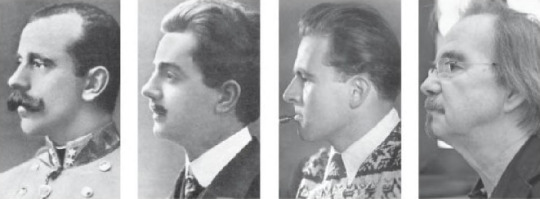#Luitpold
Explore tagged Tumblr posts
Text

1912 funeral of Luitpold Karl Joseph Wilhelm Ludwig, Prince Regent of Bavaria
German vintage postcard
#postal#german#luitpold karl joseph wilhelm ludwig#historic#ansichtskarte#joseph#sepia#wilhelm#vintage#tarjeta#1912#luitpold#ludwig#karl#briefkaart#photo#funeral#postkaart#bavaria#ephemera#postcard#postkarte#prince#photography#regent#carte postale
11 notes
·
View notes
Text
Luitpold and Alia
So here's a old doodle of Karl's kids.

2 notes
·
View notes
Text

Luitpold Domberger, 1969.
29 notes
·
View notes
Text
I am still thinking about the really badly made up german word that google translate created "Gegenseitigkeitsgesellschaften". Mainly because it's very obvious this wasn't made by a person who speaks german. Because what the fuck is this? Also because it translates it back to "mutual societies" which is clearly not the same as "mutuals".
Like, I'm allowed to make up german compound words because I know when they sound like actual words. I don't a machine understands german enough beyond "anything can be a compound word". Which sure, but a machine doesn't have logic.
#i hope our two robots don't think i mean them. they do have logic. no person without logic would call a laptop Luitpold. no?#-franz
7 notes
·
View notes
Text
Die "Heiße Liebe" von Wimmer ist wieder da!
Faschingszeit ist Krapfenzeit! Zu meiner großen Freude füllen sich in den Bäckereien die Vitrinen wieder mit allerlei saisonalem Schmalzgebäck. Die Rede ist von gute, alten Faschingskrapfen, der sowohl klassisch gepudert oder gezuckert mit Hagebutten- oder Himbeerfüllung, als auch in immer neuen Kreationen zum alsbaldigen Verzehr angeboten wird. Dass 2024 ein Krapfenjahr werden wird, hätte mir…

View On WordPress
#Bäckerei Wimmer#Faschingskrapfen#Heiße Liebe#Krapfen#Krapfenwoche#Krapfenzeit#Luitpold Wimmer#Martin Wimmer#Seraphine Wimmer#Wimmer
0 notes
Text

Salvaged German battleship SMS Prinzregent Luitpold arrives at Rosyth, Scotland, for scrapping, 12 May 1933.
77 notes
·
View notes
Text


love how ludger could withstand mental attacks from luitpold/ruipold not because his mental defense was strong, but its because there was literally nothing luitpold could do to guilt trip or break ludger further since ludger had always believed he himself was the worst/most guilty and also already made peace with the fact that he would eventually have to pay for it with his own life after he accomplishes all his goals. if nothing else, those mental attacks only strengthened his resolve to push forward and dig his grave deeper.
#academy's undercover professor#academy's undercover professor spoilers#ludger cherish#someone pls drag this man to therapy#auposting
87 notes
·
View notes
Text
Adi and Heinrich 🎉 🥳 🎂
New photo album just posted to celebrate Heini’s Special Day:
19 notes
·
View notes
Text



Princess Adelheid, Margravine [Redacted]
Born Countess Adelheid Elisabet Amalia of Celle and March; 8 May 1805 - 24 September 188x, Adelheid was the youngest child of Countess Wilhelmine of Celle and Count Bernard of March. Her elder siblings were Everette I, Grand Duke of Bergstrasse and Countess Marie-Odile of March. Adelheid was born at Schloss Celle, and christened into the Catholic faith. She was raised in the French court after the premature deaths of her parents during the Napoléonic Wars, by her elder brother. In 181x, she was arranged to marry Prince Jean, Margrave [Redacted] in what was a significant military alliance between the two families. They were married in the spring of 182x. She gave birth to nine children, only three of which survived to adulthood: Princes Stefan and Luitpold, and Princess Rudolphine. Her betrothment and marriage was a significant step up in the social climbing of her brother, Everette I, who was able to massively expand the Rodchester-Bach's wealth and prominence during the reign of Emperor Napoléon I Simparte. Adelheid never remarried after the early demise of her husband, nor did she return home to Bergstrasse. Instead, she remained in the court of her son, Prince Stefan, until her death in September of 188x. Throughout her life, she remained in close companionship with her sister-in-law, Princess Antoinette. Letters from Adelheid to her personal staff reveal that she and her Chief Lady-in-Waiting, Helene von Voss, carried on a short lived affair in the 1840s. Adelheid's original diaries and personal letters were destroyed, and/or heavily edited, by her daughter posthumously. Recordings of her life rely, mainly, upon the writings and accounts of her husband, brother, and children.
@simming-in-the-rain and @empiredesimparte for mention :)
#royal simblr#queer sims#ts4 story#sims 4 screenshots#ts4 storytelling#sims story#s4 story#ts4 royalty#simblr#sims 4#rodchester-extras#worldbuilding#lol I forgot to queue
60 notes
·
View notes
Note
Do you know about the potential marriage between Crown Prince Rudolf and Archduchess Maria Antonietta of the Tuscan branch? Read (unsure if it's accurate) how Emperor Franz Joseph I because of her tuberculosis, but reminds of Ludwig I of Bavaria initially opposing his third son Prince Luitpold marrying Archduchess Maria Antonietta's own aunt Augusta Ferdinanda who although died young, she did also bare four children who had long lives of their own.
Hello anon! This is a subject I've tried to look into, and honestly I find it equally frustrating and fascinating.


Many of Rudolf's biographers state that his first love was Archduchess Maria Antonietta, the only child of Ferdinando, last Grand Duke of Tuscany, by his first wife Princess Anna of Saxony. The story goes that they fell in love around 1878, and as you said, that she was considered a potential bride for the Crown Prince until her tuberculosis became evident. Some authors choose to end the story there, but others go even farther and talk of a secret marriage in 1880 - which would make Rudolf's marriage to Stephanie of Belgium in 1881 invalid. Maria Antonietta eventually died in 1883, at the age of 25.
But what these biographers sometimes don't mention is that in 1937 a man called Robert Pachmann claimed that he was Rudolf and Maria Antonietta's secret love child, born a month before the archduhcess' death, and that since his alleged parents had been legally married, he was the real head of the House of Habsburg and not Otto von Habsburg, Emperor Karl I's eldest son.
While before the invention of DNA tests it was very common that a person would randomly pop out claiming they were someone famous' lost child, what I find particularly interesting about this case is how FAR the Pachmanns went, going to trial several times, to the point that in 1965 Theodor Pachmann, Robert's son, was legally recognized as a Habsburg by a Vienese regional court, and again - even more explicitly - in 1976, when a judge ruled that he was a great-grandson of Franz Josef and Ferdinando of Tuscany. All these veredicts, however, were based solely on the testimony of Robert Pachmann's mother, who in 1925 stated that her son was actually Rudolf's and Maria Antonietta's. It was only in 2013 when two of Theodor's sons finally compared their DNA against a Habsburg: Georg Hohenberg, Archduke Franz Ferdinand's grandson. Which came out negative. Despite this, Robert Pachmann's descendants still claim to be descendants of Rudolf, mostly because they don't understand why Robert and Theodor would've spent so many years at court fighting for their case if it wasn't true [x].

From left to right: Crown Prince Rudolf, Robert Pachmann, Theodor Pachmann and Rainer Pachmann (Theodor's son). From Alles aus Neugier: 40 Geschichten aus 40 Jahren by Georg Markus
At this point I was so down the rabbit hole that I thought, ok, there must have been some kind of rumor about Rudolf and Maria Antonietta, and Robert Pachmann built his story around that. After all, his descendants insist that there is evidence of a "love story" between them. But here is the thing: I can't find a single mention of a potential engagement or a rumored affair between Rudolf and Maria Antonietta from before Pachmann made his claim. In fact I can't even find a single mention of Rudolf and Maria Antonietta ever being in the same room together, though I assume they must have met at least once in court. Of course, just because I haven't found it doesn't mean it doesn't exist, so if any of you ever come across any sort of story (it doesn't matter if it's just rumors!) about Rudolf and Maria Antonietta from before 1937, please let me know!
#this story is actually insane imagine winning a court case based solely on your dead mother's testimony#crown prince rudolf of austria#archduchess maria antonietta of austria-tuscany#asks
11 notes
·
View notes
Text

Luitpold Karl Joseph Wilhelm Ludwig, Prince Regent of Bavaria
German vintage postcard
#wilhelm#joseph#postal#prince#luitpold#german#vintage#postkaart#luitpold karl joseph wilhelm ludwig#ansichtskarte#photo#tarjeta#ephemera#karl#regent#ludwig#sepia#postkarte#carte postale#briefkaart#photography#bavaria#postcard#historic
5 notes
·
View notes
Text
Happy Halloween 🎃🦇🎃

Mallobaude and Luitpold dressed as Billy and Stu from Scream.
1 note
·
View note
Text

having a chill day with luitpold 🐻
2 notes
·
View notes
Text
Franz: Luitpold, das künnste do net moche!
Luitpold: *Laptopgeräusche*
#'you can't do that' 'vvvvvvvvv'#luitpold is our laptop. e.t.a. named him#windows decided to update yesterday night and because we only have one small room he started making noises while we were trying to sleep#-wolfgang#about franz
0 notes
Text
Krapfenwoche: "Heiße Liebe" von Wimmer
Mit der Bäckerei Wimmer wirft das nächste Münchner Traditionsunternehmen sein Hut – beziehungsweise Krapfen! – in den Ring. 1932 eröffneten der Firmengründer Luitpold Wimmer und seine Frau Seraphine in der Görresstraße 32 in Schwabing eine kleine Handwerksbäckerei. 1978 wurde die erste Filiale in der Leopold-, Ecke Hohenzollernstraße eröffnet, schon ein Jahr später folgte die in der Knorrstraße.…

View On WordPress
#Bäckerei Wimmer#Faschingskrapfen#Heiße Liebe#Krapfen#Krapfenwoche#Krapfenzeit#Luitpold Wimmer#Martin Wimmer#Seraphine Wimmer#Wimmer
0 notes
Text

Salvaged German battleship SMS Prinzregent Luitpold arrives at Rosyth, Scotland, for scrapping, 12 May 1933
Source
8 notes
·
View notes